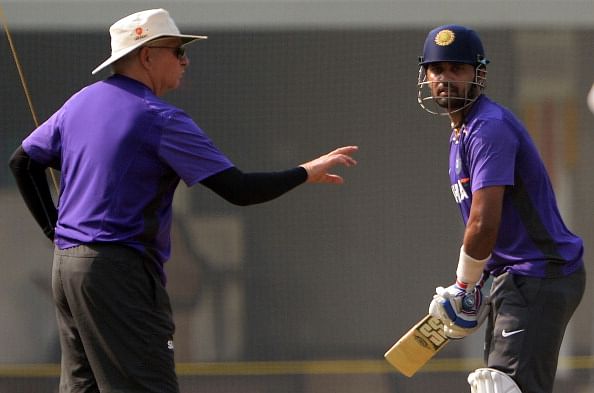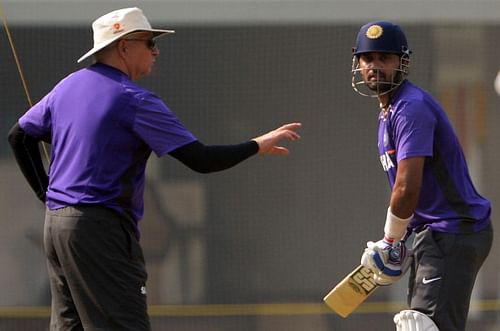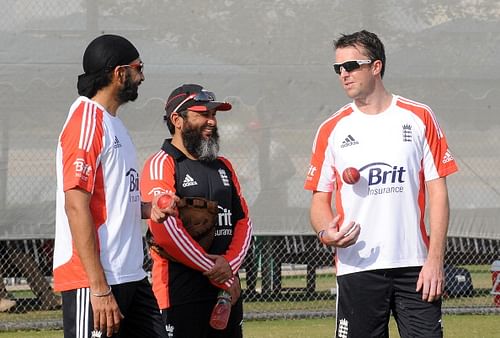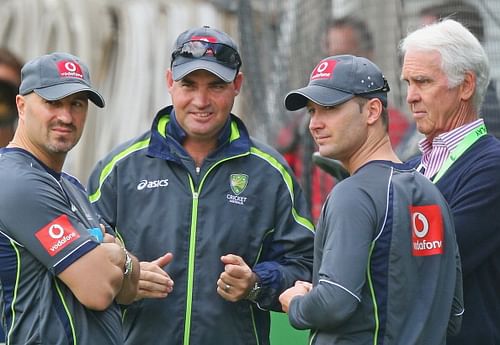
Cricket coaches: Where do you draw the line in the sand?

Among many developments, the support staff that every international and IPL team is endowed with these days shall always be marked as a frailty. Modern day cricket has gone through so many changes that it is almost unrecognizable compared to the way it was played a few years ago.
Not before 2000, did India have a foreign coach. But since then, the board’s theory has changed. The board’s opinion on foreign coaches are taken as gospel to imbibe a better work ethic, set up never-before-heard processes and deliver greater results. We have recently seen a similar effect with regional teams as well, with the likes of Orissa and Maharashtra bringing in foreign talent for coaching.
While such stories are mostly seen and heard with the sub-continent teams, teams like Australia, England and South Africa pioneered in dividing responsibilities. With a head coach in the group, teams now have specialized batting, bowling and fielding coaches. Australia also hired personnel from an entirely different sport for improving their fielding standards. England had Mushtaq Ahmed coach spin, while Gary Kirsten brought the Indian, and now the South African team, a mental conditioning coach for the players.

When the England team tours, a 15-member support staff accompanies the 16-member squad picked to play cricket. During their recent tour to India, they had a managing director, team manager, team director (head coach), fast bowling coach, spin bowling coach, batting coach, assistant coach, sports analyst, doctor, physiotherapist, strength and conditioning coach, psychologist, masseur, media manager and security manager! Now, the same England cricket team have also gone a step ahead by appointing different coaches for different formats of the game. Think about where we were in the 90s. A touring team would not even have half of these assigned roles.
The woes don’t even start here. While roles are divided very well with such a strong list of support staff, the decision making process becomes quite arduous, as each of the support staff will have his own inputs in the decisions that are taken behind closed doors. So who is, after all, the decision maker for the touring party?
Quite famous as an anomaly, the Indian team which won the Test series in England (2007), the 2007 T20 World Cup, the Perth Test (2008) and the CB Series (2008) didn’t have a head coach. They travelled with Lalchand Rajput, Robin Singh and Venkatesh Prasad to England, South Africa and Australia to claim glory. So why do you even need a coach? Cricket is mainly run by the captain, unlike a sport like football where the manager calls the shots. A coach is part of the support staff to help players improve their performances on the field.
The past decade has been a witness to many player-coach altercations. Dean Jones remarked that a coach cannot play the role of a selector and cites his own state of affairs with Bob Simpson for the same, when he was controversially dropped. More often than not, the confusion has been on who runs the team. Is it the captain or the coach?
Shane Warne openly stated that he disagreed with John Buchanan all the time. He believed that the team had to listen to Buchanan’s verbal diarrhoea, and that Buchanan over-trained his players needlessly. All this with a team which was easily the modern-day invincibles. How can we forget the famous dual-captain theory that Buchanan brought to the table with the Kolkata Knight Riders?

MELBOURNE, AUSTRALIA – DECEMBER 25: Australian captain Michael Clarke (2nd R) talks with Australian Chairman of Selectors John Inverarity (R), Australian coach Mickey Arthur and Australian Cricket Team Physiotherapist Alex Kountouris (L) during an Australian nets session at Melbourne Cricket Ground on December 25, 2012 in Melbourne, Australia. (Photo by Scott Barbour/Getty Images)
The Ganguly-Greg Chappell dispute, where the matter was about overpowering egos in public, the Kevin Pietersen-Peter Moores controversy, the Gayle-Ottis Gibson saga, the Mike Hesson-Ross Taylor discord, and now the homework gate involving Mickey Arthur and four Australian players, have all been examples of situations where the coach has exercised more powers than merely provide support to his side.
The role of the coach at international level should be a lot more subtle than what it is, say with an Under-19 or a domestic team. Players are seasoned and are better trained at the international level. You don’t often see players grooming themselves at the top level. If anything, it has to be more to do with the mental development that players need to build in order to prepare for the toughest battles at the highest level. There would, of course, be instances where players would have to work on their techniques. Even in such cases, we have seen that someone like R. Ashwin goes back to his coach in Chennai to work on his off-spin bowling, while Raina hires the personal services of Praveen Amre to help improve his technique.
Of the more successful coaching stories international cricket has seen in recent times, the Gary Kirsten tale should be the one that many of us remember better, along with Andy Flower’s in the English set-up. I don’t remember how much Andy Flower contributed during the Pietersen texting controversy last year. Pietersen had to interact a great deal with the ECB and Strauss, more than anyone else. Gary Kirsten acted as a mere bowling machine at times during his two-year stint with the Indian team. He would tirelessly send down a thousand balls in the nets for Tendulkar and the others. According to his teammates then, Kirsten focused on the aspects of preparation and mental conditioning that could get the best out of his wards. He made sure that his players knew their value and their role. He always communicated that well.

Dileep Premachandran quotes: “Kirsten comes to a press conference when no one else wants to, when the team’s had the sort of day that’s best forgotten. He’ll sit behind the microphone and defend each player, regardless of how badly they’ve performed. It’s that sort of unequivocal support that has made him so adored within the team. From the first minute of a net session to the last, he’s either giving throw-downs, hitting catches or talking to someone.”
Maybe the coaches should be reminded that we would indeed need to draw a line in the sand with their responsibilities. For God’s sake, please let the captain run the show in cricket!